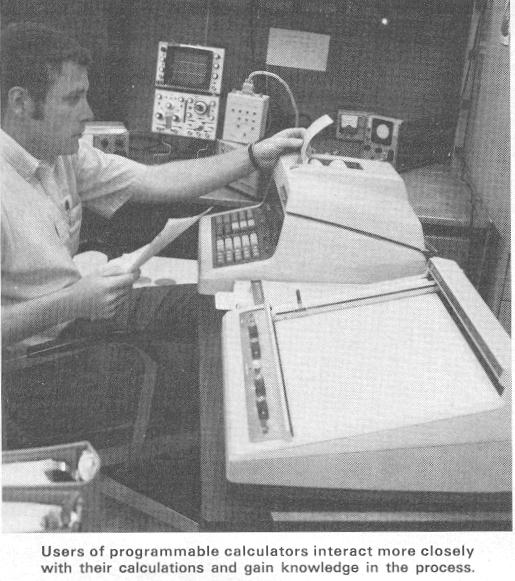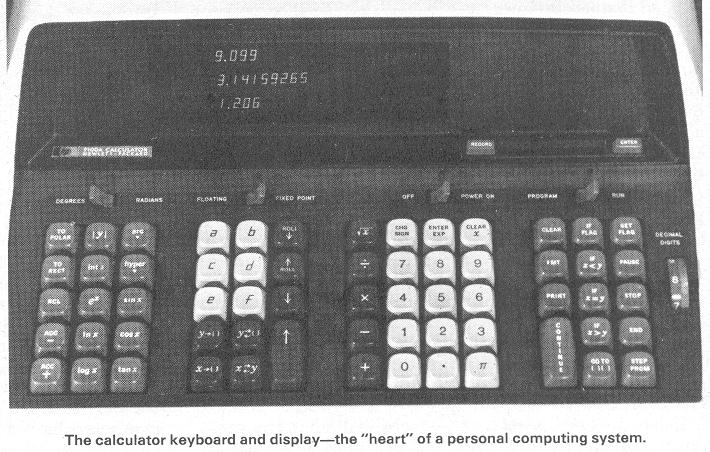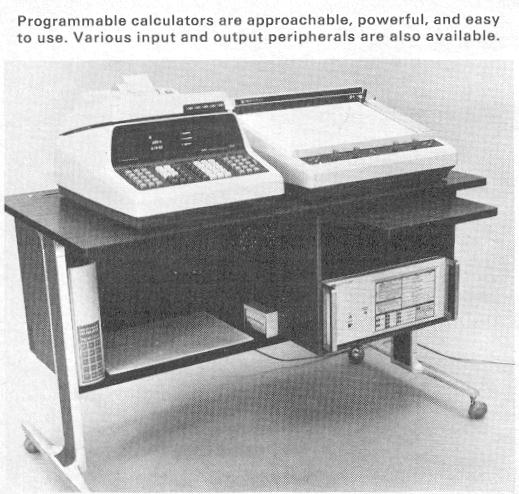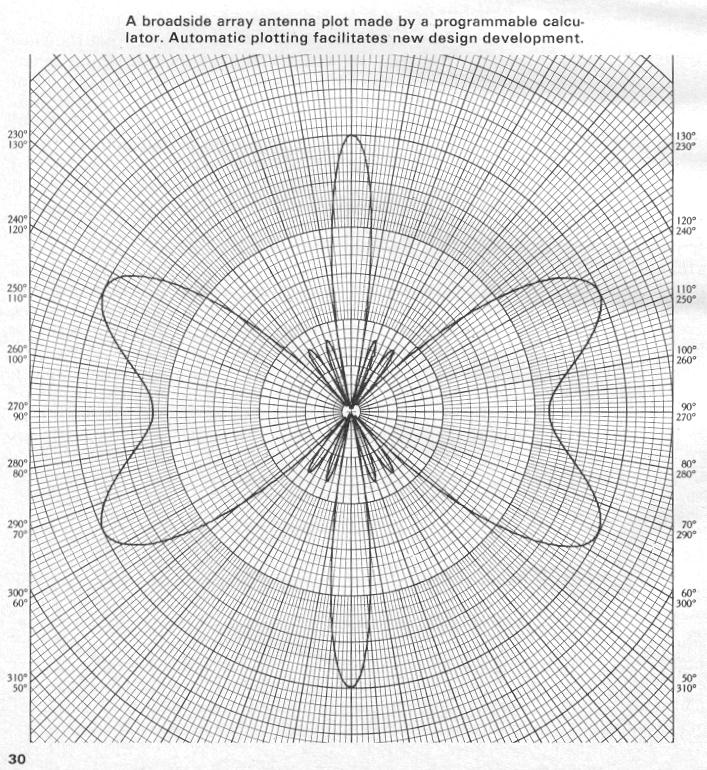[This article appeared in the September 1971 issue
of Electronics World.]
Which Computer - The Programmable Calculator?
by PAUL ASMUS/Applications Engineer
Calculator Products Div., Hewlett-Packard Co.
The author compares the desk-top
programmable calculator as an engineering tool with
mini and time-sharing types and explains why such
calculators have a unique role to fulfill.
There seems to be a new gap in the engineering and scientific
community. In fact, it is a yawning chasm. Call it the computing
gap. On one side of the gap is a computer with its awesome
power; on the other side is the slide rule, adding machine,
pencil, and you... with a fist full of problems. If you are an
engineer, scientist, technician - if you are engaged in any
type of technical work, a large part of your job involves
calculating. There are design calculations to make, reports to
prepare, and things to analyze. How many of those particular
components should be stocked? What would happen if we moved
the center frequency down to 21 kHz? What's the mean time
between failure for those modules? How many of those parts do
we have to test to be sure they are going to meet a certain spec?
And the list goes on.
Some problems are a perfect match for a computer: they are big;
they are unwieldy; they require lots of data; and they don't
require much human interaction. Quite a few problems can be done
in your head or just scratched out in 20 seconds on a piece of
paper. But an uncomfortably large percentage of calculations
that have to be made fall right in the middle of the computing gap.
Some of them are too small to put on a computer, but too big to
do in your head or on a slide rule. Some are things you never
really decided how best to handle, or things that had to be done
by a certain time but couldn't be processed through the system
soon enough. All are things that, for one reason or another,
did not fit the computer and just couldn't be done by hand. As a
result of their falling into the gap, many of these
problems never get solved to your satisfaction. They
get worked out one way or another - maybe you guess that a 10%
resistor would do. A "wet finger in the wind" told you that
if you tested five of them, the rest would be OK. You never
knew for sure. You never got that answer you wanted. Some of
these problems may still be around.
Bridging the Gap
 The programmable calculator bridges the computer gap because
it's approachable and personal: approachable because it is easy
to use - almost self-explanatory, and personal becuase it's
flexible enough to be tailored to your requirements. You set it
up to do what you need in the way you need it done. And even
though it is as approachable as your slide rule it still has
much of the calculating power of a big computer.
The programmable calculator bridges the computer gap because
it's approachable and personal: approachable because it is easy
to use - almost self-explanatory, and personal becuase it's
flexible enough to be tailored to your requirements. You set it
up to do what you need in the way you need it done. And even
though it is as approachable as your slide rule it still has
much of the calculating power of a big computer.
Inside, the programmable calculator is really a small computer:
it has a memory, it has control, input-output elements, it stores
data, and it can be programmed. On the outside it's quite
different. It is small - about the size of a typewriter - and
has a keyboard and display. The display is numerical,
showing answers and interim results. Most calculators display
the contents of two or three registers where calculations are
done.
The keyboard is an "English language" one, much like
that of an adding machine. Parts of it actually operate like
an adding machine. There is a plus key for adding, a minus
key for subtracting, there are keys for finding square roots
or even cosines. When a key is pressed, the result is
displayed immediately. The keyboards of most programmable
calculators are divided into four main functional groups:
the arithmetic group, storage group, special-function
group, and programming group.
Some where near the center of the keyboard will be the
arithmetic group. This group facilitates number entry
and includes all arithmetic operations: add, subtract,
multiply, divide, and square root. Numbers can be entered
either on decimal or scientific notation (powers of 10).
Most programmable calculators display at least 10 digits.
Numbers entered can be displayed either in scientific
notation or in straightforward decimal notation, with as
many decimal places as the user needs. Although the machine
always calculates its answers to 12 places, you can have the
answer displayed with only two-place accuracy and it will
even round the answer for you.

The second group of keys, usually located in close proximity
to the arithmetic group, is for storage and manipulation.
These keys control storage and exchange of numbers between
display and storage. Numbers storage is easy - simply
press a storage instruction key and the key corresponding
to the desired storage location, and the number is stored.
To get the number back, press the recall instruction key
and the key corresponding to the storage location.
Sometimes recall is done with a single key stroke. For
example, in the keyboard shown in the photograph, to store
the contents of the X-display register in the register called
"d" one simply presses the key stroke sequence
"x->()," "d" (called "x to" d). To recall that number, the
"d" key is pressed.
The third group, which gives the unit extra calculating power,
is a special-function group. The special-function group includes
commonly used mathematical functions, such as trig functions, logs,
square roots, and exponentials. Often these keys include such
functions as rectangular-to-polar conversion or single key-stroke
summations. All functions are represented by a single key; to find
the sine of a number, simply enter the number via the
arithmetic keyboard and press the sine key.
Given the first three blocks of keys, the calculator becomes
an electronic slide rule, combining the best features of an
adding machine, a slide rule, and a book of tables. Expressions
like e = EF(1 - e-t/RC),
the voltage on a capacitor, can be determined in seconds with
just a few operations. No special training is required - only
an understanding of what each key does. Most programmable
calculators have a pull-out card which explains what each key
does and gives examples of how the keys work. It is possible
for a person totally unfamiliar with a calculator to do a
fairly complicated problem on the calculator the very first
time he tries. As a matter of fact, this has been the experience
of many calculator users.
The fourth and final key block is for programming.
This set of keys controls the program mode of the
calculator and defines certain functions necessary for programming,
such as starting a program, stopping a program, taking data from
input devices or sending data in a peripheral, branching to
a different part of a program, making a decision, etc.
Calculator programs are written by switching the calculator
to a "program" or "learn" mode; pressing the keys corresponding
to the desired operation in the same sequence that would have
been used to do the calculation manually; and then switching
back to the "run" mode. Several keys in the programming keyboard
must be used at the beginning of the program and at various points
in the program, in addition to the keys needed to do the
calculation manually. Anyone who can do a calculation manually
can write a program for his calculation. The transition from
machine operation ot machine programming is an easy one. Most
people can learn to program a calculator in less than one
working day and become proficient calculator programmers in
a few days.
 Besides being approachable, easy to use, and easy to program,
programmable calculators are powerful and accurate, with
accuracies generally on the order of one part in a
trillion and dynamic ranges large enough to simultaneously
handle numbers as small as 10-98 and as large
as 1099. Handling picofarads and megaohms in the
same expression is no problem. Most programmable calculators
can handle programs varying in length from about 200 program
steps for a basic machine to about 3500 steps for a fully
expanded machine, where each program step represents one
keyboard key-stroke. Basic calculators with memories in the
200 to 500 program step range can handle various problems
including statistics, electrical engineering, solutions to
four simultaneous equations, amplifier gain and phase
calculations, simple filter designs, conversions from 8 parameters
to other parameters, and so on.
Besides being approachable, easy to use, and easy to program,
programmable calculators are powerful and accurate, with
accuracies generally on the order of one part in a
trillion and dynamic ranges large enough to simultaneously
handle numbers as small as 10-98 and as large
as 1099. Handling picofarads and megaohms in the
same expression is no problem. Most programmable calculators
can handle programs varying in length from about 200 program
steps for a basic machine to about 3500 steps for a fully
expanded machine, where each program step represents one
keyboard key-stroke. Basic calculators with memories in the
200 to 500 program step range can handle various problems
including statistics, electrical engineering, solutions to
four simultaneous equations, amplifier gain and phase
calculations, simple filter designs, conversions from 8 parameters
to other parameters, and so on.
A good example is an RC timing or trigger circuit design
program written by one user. This program can calculate either
capacitor value, resistor value, critical voltage, or delay time.
Given any three values, the calculator finds the fourth. Then the
program allows the operator to change any of the four values and
note the effect on any of the other three. For example, he can
change the resistor from the calculated value to the next closest
standard value and note the effect on delay time, or can change
capacitance value in a similar way; or vary the resistance value
10% to see how resistor tolerance will affect delay time. This isn't
a complicated calculation, but does involve manipulation of
exponential functions. It could be done on a slide rule or with a
book of tables, but on the calculator it is done more quickly.
And it allows the engineer to optimize the circuit instead of
just design it, probably in less time than it would have
taken him to do one calculation by hand. Here we have a problem
too small for a computer and just a bit too complex to do by hand - one
that probably wouldn't get done without a calculator.
A fully expanded calculator, one with 3000 to 4000 steps,
almost rivals a small computer in capability. Such a
calculator can do a problem like an RCL network
analysis with 15 nodes and as many as 45 components,
and plot results on a Smith chart or log paper; or could
fit a 12th order curve to a set of data points, or invert
a 14 x 14 matrix. Although such a calculator, fully
expanded, virtually matches a small computer in capability,
it still is as easy to use as a basic calculator.
Inputs and Outputs
There is more to a problem than just getting an answer; there's
the matter of getting results in a usable form. Basic calculators
can be expanded to include a wide variety of peripherals to
generate outputs and accept inputs in about any form the user
desires. There are printers, fast, quiet, reliable and inexpensive;
there are typewriters and teletypewriters for fully formatted
outputs, for filling out forms and reports; there are X-Y plotters
to help provide the invaluable insight that only plots and graphs
can give; there are tape readers, card readers, and interfaces to
measuring instruments; and there are large-screen displays,
memory extenders, and even a new peripheral called the
"Digitizer" that allows graphical data from a plotter or hand-drawn
graphs to be entered into the calculator. The calculator system
can be configured to meet almost any requirement and
then later expanded and modified to meet different requirements.
Get a calculator now; as your work load increases replace the printer
with a typewriter and keep the printer for smaller jobs, or add a
plotter. As the need for larger programs arises, expand the
memory to handle them. A fully expanded system with all the
peripherals is still just as approachable as your slide rule.
More than a Calculator
Calculators offer much more than just solutions to problems.
They make better engineers and technicians by helping them
make better decisions. They help people learn about computing,
about computers, about mathematics and programming, and more
about the work they are doing.
For example, the programmable calculator encourages people to
do things they might not otherwise tackle. A perfect example
of this is the RC timing circuit program mentioned
earlier. Here is a problem that might not have been solved
without a calculator. But, because the calculator was so easy
to program, maybe even fun to program, someone wrote a program
to solve a simple but persistent problem that had been around
for a while. And it turned out to be quite valuable. This will,
in turn, encourage an engineer to try other things - maybe,
"I haven't time to mess with that" will be replaced by "Let's
try that on the calculator."
A programmable calculator can also stimulate new awareness and
insight. Since the calculator is so easy to use and program, it
is possible to interact more closely with the problem. Freed from
the leg work of setting up the problem, users have time to take
a closer look at what they are doing. Consider, for example,
and engineer designing an antenna. One of the tools he uses is
a pattern plot or plot of field-strength versus direction.
Although calculations involved in making such a plot are not
especially difficult, they are often messy and time consuming;
nothing really unusual in them, but lots of sines and
cosines to look up and lots of things to jot down. A plot
program is easily prepared for a programmable calculator,
especially one with build-in trig and single-step
rectangular-to-polar conversion functions. With the calculator
and a peripheral plotter, a finished plot is ready in less time
than it would have taken to calculate one point by hand. So,
instead of making just one plot, the designer decides to change
a couple of variables and make another plot; in fact, several
plots - he changes the number of turns of this and terminations
of that, or length of the other. Pretty soon he starts to
notice things: that back lobe which wouldn't meet Federal specifications
alternately widens and narrows as he varies the length of one of
the elements; or those pesky side lobes start to disappear as the
number of turns exceeds a certain figure. He's gaining insight
into what antennas are all about. Next time he designs an
antenna, he'll know more about it because he learned while
doing calculations.

There are other benefits, too; for example, having calculator
power available when you need it, as in lab situtations where it
is important to process data as soon as it appears or when a
production facility must be shut down while someone decides
on a course of action. Also, people who have never used computers
or calculators before will be encouraged to try their hand on a
programmable calculator.
Then there is the matter of cost. A programmable calculator
system can be put to work for less than $1 per computing hour.
One survey conducted by Hewlett-Packard indicated that
its customers feel that an average of 58 percent of all the
calculating they had to do could be done on their
programmable calculators; while 16 percent reported that
90 percent of their work could be handled on a programmable
calculator. The basic calculator system costs less than
$4000 but can be enlarged to a fully expanded system with
all peripherals for an additional $10,000. The most
expensive calculator system one can configure would cost
less than $20,000 and rival a small computer in capability.
A calculator system which would meet the needs of most
people would cost about $5000.
What about Mini and Time-Share Computers?
In general, it can be said that calculators make poor computers
and computers make poor calculators. That is to say nothing
derogatory about either computers or calculators but rather
to point out that they aren't really competitive. One does
not use a calculator instead of a computer and vice versa.
Each is designed to handle a specific job and are complementary.
Calculators are useful for those jobs that fall in the gap -
jobs that don't get done now, jobs that need your personal
attention, and ones no one seems to have time to do.
Calculators are designed to help people interact with their
problems. Computers - big computers, small computers, and
time share - have wider scope; they can perform more complicated
calculations in much less time - often for a great deal more
money. They can accommodate many users and many different
languages. They are general-purpose machines, intended for no
specific kind of problem, but capable, after some programming,
of handling about any task.
But the more general the device, the more one must know about
it in order to use it profitably. There is no way of looking
at a computer and telling what it is doing, where its answers
are, or even what programming language it is using. One
doesn't just walk up to a computer and ask what
(1 - e.06) is. One doesn't look at a
computer or a time-share terminal and get the answers; the
user must program it to present the answers on one of the
many output devices. But, once a person understands how to
use the computer, he has almost unlimited computing power.
If a computer is to be utilized effectively, it must serve
many people, and so must be administered. Anything an
intended user wishes to do must pass, to some extent,
through that administration. One doesn't just walk up and
grab a computer. Thus a computer is less approachable
than a calculator, and necesssarily so.
Organizations faced with a wide variety of problems find that
a combination of calculators and computers gives them the
best return for their computing dollar and best utilization
of their people. This way there is something for everyone;
calculators aren't overtaxed to the point where they become
inefficient and computers aren't tied up doing simple problems.
They also find that computer familiarization is easier and that
people who learn about calculators and computers have a better
understanding of each.
How Do You Pick a Calculator?
The best answer - considering a calculator as a personal
computing system - is to select a calculator which you,
the user, feel will best handle your requirements and your
problems. Since programmable calculators are a relatively
new product, there is disagreement as to what constitutes
the "best" calculator. Some say it's the one with the most
program steps; others say the one with the most built-in
functions; still others insist it is the one that weighs the
least, or has the most peripherals. If it were only a matter
of program steps, then the best choice wouldn't even be a
calculator, since there are many computing equipment devices
that have more program steps than the biggest calculator.
If it were a matter of weight, a slide rule would win.
It is not inconceivable that you might even consider the calculator's
portability if you need it away from your office. Some engineers
are known to take their calculators along with them on business trips.
Remember, the programmable calculator was designed to be a personal,
interactive computing system to help you solve problems the way
you want them solved. So, your calculator must be easy to use,
easy to understand, easy to program, and flexible enough to meet
your changing needs. Perhaps the best way to choose a programmable
calculator is to try several and choose the one that best fits
the way you plan to use it. Try it out on one of your problems to
see how easy it is to program. After all, it is to be your
personal computing system.
Programmable calculators have helped close the computing gap.
Now there is a calculating tool for almost every kind of problem.
The trend in calculators will most certainly be towards smaller
units, with greather capability, that are even easier to use and
easier to program - probably at lower prices. There will be more
peripherals and they will be more flexible. Advances in
electronics technology will make possible large amounts of
calculating capability in a box no larger than a typewriter,
yet still be as approachable as your slide rule.
Last modified October 15, 2002.
Comments to Dan Veeneman
Click here
for the HP 9100 page.
Click here
for the Calculator page.
Click here
for the main page.
 The programmable calculator bridges the computer gap because
it's approachable and personal: approachable because it is easy
to use - almost self-explanatory, and personal becuase it's
flexible enough to be tailored to your requirements. You set it
up to do what you need in the way you need it done. And even
though it is as approachable as your slide rule it still has
much of the calculating power of a big computer.
The programmable calculator bridges the computer gap because
it's approachable and personal: approachable because it is easy
to use - almost self-explanatory, and personal becuase it's
flexible enough to be tailored to your requirements. You set it
up to do what you need in the way you need it done. And even
though it is as approachable as your slide rule it still has
much of the calculating power of a big computer.

 Besides being approachable, easy to use, and easy to program,
programmable calculators are powerful and accurate, with
accuracies generally on the order of one part in a
trillion and dynamic ranges large enough to simultaneously
handle numbers as small as 10-98 and as large
as 1099. Handling picofarads and megaohms in the
same expression is no problem. Most programmable calculators
can handle programs varying in length from about 200 program
steps for a basic machine to about 3500 steps for a fully
expanded machine, where each program step represents one
keyboard key-stroke. Basic calculators with memories in the
200 to 500 program step range can handle various problems
including statistics, electrical engineering, solutions to
four simultaneous equations, amplifier gain and phase
calculations, simple filter designs, conversions from 8 parameters
to other parameters, and so on.
Besides being approachable, easy to use, and easy to program,
programmable calculators are powerful and accurate, with
accuracies generally on the order of one part in a
trillion and dynamic ranges large enough to simultaneously
handle numbers as small as 10-98 and as large
as 1099. Handling picofarads and megaohms in the
same expression is no problem. Most programmable calculators
can handle programs varying in length from about 200 program
steps for a basic machine to about 3500 steps for a fully
expanded machine, where each program step represents one
keyboard key-stroke. Basic calculators with memories in the
200 to 500 program step range can handle various problems
including statistics, electrical engineering, solutions to
four simultaneous equations, amplifier gain and phase
calculations, simple filter designs, conversions from 8 parameters
to other parameters, and so on.
